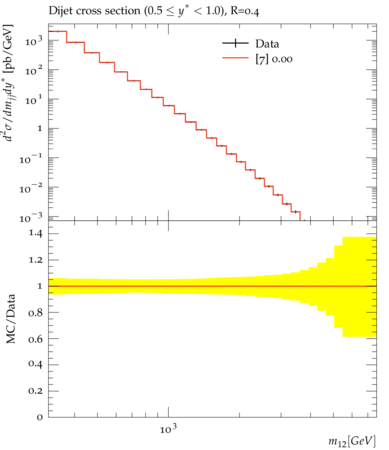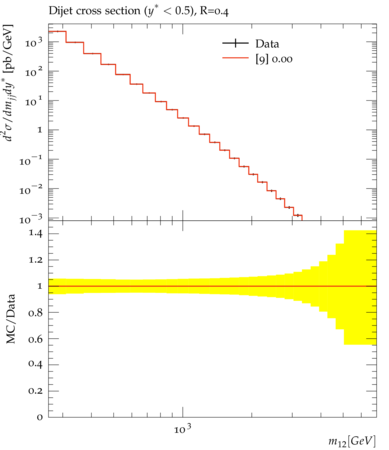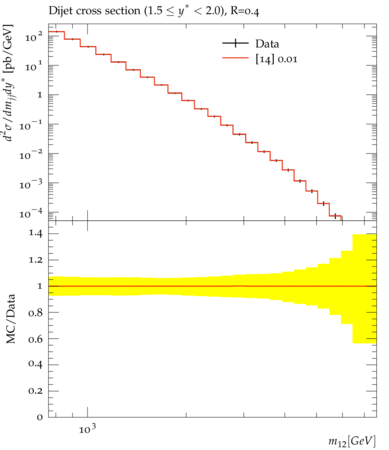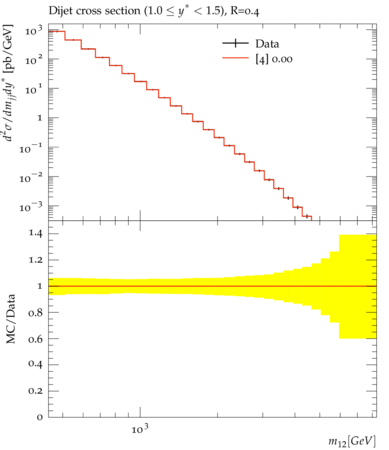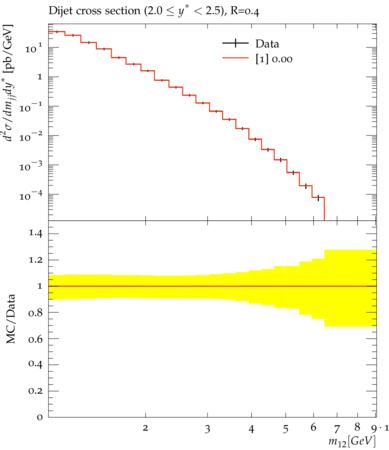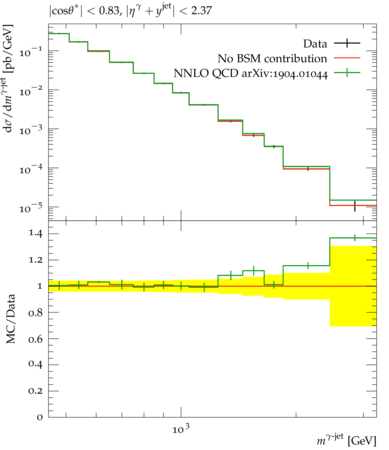Analysis Pool:ATLAS_13_JETS
Analysis Pool:CMS_13_JETS
Analysis Pool:ATLAS_13_WW
Analysis Pool:CMS_13_LMETJET
Analysis Pool:CMS_13_MMETJET
Analysis Pool:ATLAS_13_MMJET
Analysis Pool:ATLAS_13_EEJET
Analysis Pool:ATLAS_13_TTHAD
Analysis Pool:ATLAS_13_LMETJET
Analysis Pool:ATLAS_13_4L
Analysis Pool:ATLAS_13_METJET
List of all the analyses which were tried:
Measurement of $ZZ -> 4\ell$ production at 13 TeV (ATLAS_2017_I1625109) in pool ATLAS_13_4L
Inspire | HepData | Phys.Rev. D97 (2018) no.3, 032005 | doi:10.1103/PhysRevD.97.032005 | arXiv:1709.07703 [hep-ex]
Measurements of $ZZ$ production in the $\ell^+\ell^-\ell^{\prime +}\ell^{\prime -}$-channel in proton--proton collisions at 13 TeV center-of-mass energy at the Large Hadron Collider are presented. The data correspond to 36.1 fb${}^{-1}$ of collisions collected by the ATLAS experiment in 2015 and 2016. Here $\ell$ and $\ell^\prime$ stand for electrons or muons. Integrated and differential $ZZ\to \ell^+\ell^-\ell^{\prime +}\ell^{\prime -}$-cross sections with $Z\to\ell^+\ell^-$-candidate masses in the range of 66 GeV to 116 GeV are measured in a fiducial phase space corresponding to the detector acceptance and corrected for detector effects. The differential cross sections are presented in bins of twenty observables, including several that describe the jet activity. The integrated cross section is also extrapolated to a total phase space and to all standard model decays of $Z$ bosons with mass between 66 GeV and 116 GeV, resulting in a value of 17.3$\pm$0.9[$\pm$0.6(stat)$\pm$0.5(syst)$\pm$0.6(lumi)] pb. The measurements are found to be in good agreement with the standard model. A search for neutral triple gauge couplings is performed using the transverse momentum distribution of the leading $Z$ boson candidate. No evidence for such couplings is found and exclusion limits are set on their parameters.
Inclusive 4-lepton lineshape at 13 TeV (ATLAS_2019_I1720442) in pool ATLAS_13_4L
Inspire | HepData | Submitted to JHEP | arXiv:1902.05892 [hep-ex]
A measurement of the four-lepton invariant mass spectrum is made with the ATLAS detector, using an integrated luminosity of 36.1 fb$^{-1}$ of proton-proton collisions at $\sqrt{s} = 13$ TeV delivered by the Large Hadron Collider. The differential cross-section is measured for events containing two same-flavour opposite-sign lepton pairs. It exhibits a rich structure, with different mass regions dominated in the Standard Model by single $Z$ boson production, Higgs boson production, and $Z$ boson pair production, and non-negligible interference effects at high invariant masses. The measurement is compared with state-of-the-art Standard Model calculations, which are found to be consistent with the data. These calculations are used to interpret the data in terms of $gg\to ZZ\to 4\ell$ and $Z\to 4\ell$ subprocesses, and to place constraints on a possible contribution from physics beyond the Standard Model.
Z plus jets at 13 TeV (ATLAS_2017_I1514251) in pool ATLAS_13_EEJET
Inspire | HepData | arXiv:1702.05725 [hep-ex] | submitted to EPJC
Measurements of the production cross section of a $Z$ boson in association with jets in proton-proton collisions at i $\sqrt{s}=13$ TeV are presented, using data corresponding to an integrated luminosity of 3.16 fb${}^{-1}$ collected by the ATLAS experiment at the CERN Large Hadron Collider in 2015. Inclusive and differential cross sections are measured for events containing a $Z$ boson decaying to electrons or muons and produced in association with up to seven jets with $p_\text{T}>30$ GeV and $|y|<2.5$. Predictions from different Monte Carlo generators based on leading-order and next-to-leading-order matrix elements for up to two additional partons interfaced with parton shower and fixed-order predictions at next-to-leading order and next-to-next-to-leading order are compared with the measured cross sections. Good agreement within the uncertainties is observed for most of the modelled quantities, in particular with the generators which use next-to-leading-order matrix elements and the more recent next-to-next-to-leading-order fixed-order predictions.
Control region measurements for leptoquark search at 13 TeV (ATLAS_2019_I1718132) in pool ATLAS_13_EEJET
Inspire | HepData | arXiv:1902.00377 [hep-ex] | submitted to EPJC
Searches for scalar leptoquarks pair-produced in proton-proton collisions at $\sqrt{s} = 13$ TeV at the Large Hadron Collider are performed by the ATLAS experiment. A data set corresponding to an integrated luminosity of 36.1 fb${}^{-1}$ is used. Final states containing two electrons or two muons and two or more jets are studied, as are states with one electron or muon, missing transverse momentum and two or more jets. No statistically significant excess above the Standard Model expectation is observed. The observed and expected lower limits on the leptoquark mass at 95% confidence level extend up to 1.25 TeV for first- and second-generation leptoquarks, as postulated in the minimal Buchmuller-Ruckl-Wyler model, assuming a branching ratio into a charged lepton and a quark of 50%. In addition, measurements of particle-level fiducial and differential cross sections are presented for the $Z\to ee$, $Z\to\mu\mu$ and $t\bar{t}$ processes in several regions related to the search control regions. Predictions from a range of generators are compared with the measurements, and good agreement is seen for many of the observables. However, the predictions for the $Z\to\ell\ell$ measurements in observables sensitive to jet energies disagree with the data.
Isolated photon + jets at 13 TeV (ATLAS_2017_I1645627) in pool ATLAS_13_GAMMA
Inspire | HepData | Phys.Lett. B780 (2018) 578-602 | doi:10.1016/j.physletb.2 | arXiv:1801.00112 [hep-ex]
The dynamics of isolated-photon production in association with a jet in proton-proton collisions at a centre-of-mass energy of 13 TeV are studied with the ATLAS detector at the LHC using a dataset with an integrated luminosity of 3.2 fb$^{-1}$. Photons are required to have transverse energies above 125 GeV. Jets are identified using the anti-$k_\text{t}$ algorithm with radius parameter $R=0.4$ and required to have transverse momenta above 100 GeV. Measurements of isolated-photon plus jet cross sections are presented as functions of the leading-photon transverse energy, the leading-jet transverse momentum, the azimuthal angular separation between the photon and the jet, the photon-jet invariant mass and the scattering angle in the photon-jet centre-of-mass system. Tree-level plus parton-shower predictions from Sherpa and Pythia as well as next-to-leading-order QCD predictions from Jetphox and Sherpa are compared to the measurements.
ATLAS Inclusive jet and dijet cross section measurement at sqrt(s)=13TeV (ATLAS_2018_I1634970) in pool ATLAS_13_JETS
Inspire | HepData | JHEP 1805 (2018) 195 | arXiv:1711.02692
Inclusive jet and dijet cross-sections are measured in proton-proton collisions at a centre-of-mass energy of 13 TeV. The measurement uses a dataset with an integrated luminosity of 3.2 fb$^{-1}$ recorded in 2015 with the ATLAS detector at the Large Hadron Collider. Jets are identified using the anti-$k_\text{t}$ algorithm with a radius parameter value of $R = 0.4$. The inclusive jet cross-sections are measured double-differentially as a function of the jet transverse momentum, covering the range from 100 GeV to 3.5 TeV, and the absolute jet rapidity up to $|y| = 3$. The double-differential dijet production cross-sections are presented as a function of the dijet mass, covering the range from 300 GeV to 9 TeV, and the half absolute rapidity separation between the two leading jets within $|y| < 3$, $y^\ast$, up to $y^\ast = 3$. Next-to-leading-order, and next-to-next-to-leading-order for the inclusive jet measurement, perturbative QCD calculations corrected for non-perturbative and electroweak effects are compared to the measured cross-sections.
Resolved and boosted ttbar l+jets cross sections at 13 TeV (ATLAS_2017_I1614149) in pool ATLAS_13_LMETJET
Inspire | HepData | JHEP 1711 (2017) 191 | doi:10.1007/JHEP11(2017)1 | arXiv:1708.00727 [hep-ex]
Measurements of differential cross-sections of top-quark pair production in fiducial phase-spaces are presented as a function of top-quark and $t\bar{t}$ system kinematic observables in proton-proton collisions at a centre-of-mass energy of $\sqrt{s} = 13$ TeV. The data set corresponds to an integrated luminosity of 3.2 fb${}^{-1}$, recorded in 2015 with the ATLAS detector at the CERN Large Hadron Collider. Events with exactly one electron or muon and at least two jets in the final state are used for the measurement. Two separate selections are applied that each focus on different top-quark momentum regions, referred to as resolved and boosted topologies of the $t\bar{t}$ final state. The measured spectra are corrected for detector effects and are compared to several Monte Carlo simulations by means of calculated $\chi^2$ and $p$-values.
Differential $t\bar{t}$ $l$+jets cross-sections at 13 TeV (ATLAS_2018_I1656578) in pool ATLAS_13_LMETJET
Inspire | HepData | Submitted to JHEP | arXiv:1802.06572 [hep-ex]
Measurements of differential cross sections of top quark pair production in association with jets by the ATLAS experiment at the LHC are presented. The measurements are performed as functions of the top quark transverse momentum, the transverse momentum of the top quark-antitop quark system and the out-of-plane transverse momentum using data from pp collisions at $\sqrt{s}=13$ TeV collected by the ATLAS detector at the LHC in 2015 and corresponding to an integrated luminosity of 3.2 $\text{fb}^{-1}$. The top quark pair events are selected in the lepton (electron or muon) + jets channel. The measured cross sections, which are compared to several predictions, allow a detailed study of top quark production.
ttbb at 13 TeV (ATLAS_2018_I1705857) in pool ATLAS_13_LMETJET
Inspire | HepData | submitted to JHEP | arXiv:1811.12113 [hep-ex]
This paper presents measurements of $t\bar{t}$ production in association with additional $b$-jets in $pp$ collisions at the LHC at a centre-of-mass energy of 13 TeV. The data were recorded with the ATLAS detector and correspond to an integrated luminosity of 36.1 fb$^{-1}$. Fiducial cross-section measurements are performed in the dilepton and lepton-plus-jets $t\bar{t}$ decay channels. Results are presented at particle level in the form of inclusive cross-sections of $t\bar{t}$ final states with three and four $b$-jets as well as differential cross-sections as a function of global event properties and properties of $b$-jet pairs. The measured inclusive fiducial cross-sections generally exceed the $t\bar{t}b\bar{b}$ predictions from various next-to-leading-order matrix element calculations matched to a parton shower but are compatible within the total uncertainties. The experimental uncertainties are smaller than the uncertainties in the predictions. Comparisons of state-of-the-art theoretical predictions with the differential measurements are shown and good agreement with data is found for most of them.
$p_T^\text{miss}$+jets cross-section ratios at 13 TeV (ATLAS_2017_I1609448) in pool ATLAS_13_METJET
Inspire | HepData | arXiv:1707.03263 [hep-ex] | Eur.Phys.J. C77 (2017) no.11, 765 | doi:10.1140/epjc/s10052-017-5315-6
Observables sensitive to the anomalous production of events containing hadronic jets and missing momentum in the plane transverse to the proton beams at the Large Hadron Collider are presented. The observables are defined as a ratio of cross sections, for events containing jets and large missing transverse momentum to events containing jets and a pair of charged leptons from the decay of a $Z/\gamma^\ast$ boson. This definition minimises experimental and theoretical systematic uncertainties in the measurements. This ratio is measured differentially with respect to a number of kinematic properties of the hadronic system in two phase-space regions; one inclusive single-jet region and one region sensitive to vector-boson-fusion topologies. The data are found to be in agreement with the Standard Model predictions and used to constrain a variety of theoretical models for dark-matter production, including simplified models, effective field theory models, and invisible decays of the Higgs boson. The measurements use 3.2 fb${}^{-1}$ of proton-proton collision data recorded by the ATLAS experiment at a centre-of-mass energy of 13 TeV and are fully corrected for detector effects, meaning that the data can be used to constrain new-physics models beyond those shown in this paper. The reference data file comes with the measured $R^\text{miss}$ (y01), the expected $R^\text{miss}$ in the Standard Model (y02), the expected $R^\text{miss}$ numerator in the Standard Model (y03) as well as the expected $R^\text{miss}$ denominator in the Standard Model (y04). If no mode is specified, will assume routine is being run on BSM model and attempt to combine with SM prediction from ref data file. If NU is specified will assume SM $Z\to\nu\nu$ is being run on. If EL or MU is specified, will assume routine is run on SM $Z\to ee$ or $Z\to\mu\mu$ respectively.'
Z plus jets at 13 TeV (ATLAS_2017_I1514251) in pool ATLAS_13_MMJET
Inspire | HepData | arXiv:1702.05725 [hep-ex] | submitted to EPJC
Measurements of the production cross section of a $Z$ boson in association with jets in proton-proton collisions at i $\sqrt{s}=13$ TeV are presented, using data corresponding to an integrated luminosity of 3.16 fb${}^{-1}$ collected by the ATLAS experiment at the CERN Large Hadron Collider in 2015. Inclusive and differential cross sections are measured for events containing a $Z$ boson decaying to electrons or muons and produced in association with up to seven jets with $p_\text{T}>30$ GeV and $|y|<2.5$. Predictions from different Monte Carlo generators based on leading-order and next-to-leading-order matrix elements for up to two additional partons interfaced with parton shower and fixed-order predictions at next-to-leading order and next-to-next-to-leading order are compared with the measured cross sections. Good agreement within the uncertainties is observed for most of the modelled quantities, in particular with the generators which use next-to-leading-order matrix elements and the more recent next-to-next-to-leading-order fixed-order predictions.
Control region measurements for leptoquark search at 13 TeV (ATLAS_2019_I1718132) in pool ATLAS_13_MMJET
Inspire | HepData | arXiv:1902.00377 [hep-ex] | submitted to EPJC
Searches for scalar leptoquarks pair-produced in proton-proton collisions at $\sqrt{s} = 13$ TeV at the Large Hadron Collider are performed by the ATLAS experiment. A data set corresponding to an integrated luminosity of 36.1 fb${}^{-1}$ is used. Final states containing two electrons or two muons and two or more jets are studied, as are states with one electron or muon, missing transverse momentum and two or more jets. No statistically significant excess above the Standard Model expectation is observed. The observed and expected lower limits on the leptoquark mass at 95% confidence level extend up to 1.25 TeV for first- and second-generation leptoquarks, as postulated in the minimal Buchmuller-Ruckl-Wyler model, assuming a branching ratio into a charged lepton and a quark of 50%. In addition, measurements of particle-level fiducial and differential cross sections are presented for the $Z\to ee$, $Z\to\mu\mu$ and $t\bar{t}$ processes in several regions related to the search control regions. Predictions from a range of generators are compared with the measurements, and good agreement is seen for many of the observables. However, the predictions for the $Z\to\ell\ell$ measurements in observables sensitive to jet energies disagree with the data.
All-hadronic boosted ttbar at 13 TeV (ATLAS_2018_I1646686) in pool ATLAS_13_TTHAD
Inspire | HepData | doi:10.17182/hepdata.81709.v1 | arXiv:1801.02052 [hep-ex]
Measurements are made of differential cross-sections of highly boosted pair-produced top quarks as a function of top-quark and $t\bar{t}$ system kinematic observables using proton--proton collisions at a center-of-mass energy of $\sqrt{s}=13$ TeV. The data set corresponds to an integrated luminosity of 36.1 fb${}^{-1}$, recorded in 2015 and 2016 with the ATLAS detector at the CERN Large Hadron Collider. Events with two large-radius jets in the final state, one with transverse momentum pT>500 GeV and a second with $p_\text{T} > 350$ GeV, are used for the measurement. The top-quark candidates are separated from the multijet background using jet substructure information and association with a $b$-tagged jet. The measured spectra are corrected for detector effects to a particle-level fiducial phase space and a parton-level limited phase space, and are compared to several Monte Carlo simulations by means of calculated $\chi^2$ values. The cross-section for $t\bar{t}$ production in the fiducial phase-space region is 292$\pm$7 (stat)$\pm$76(syst) fb, to be compared to the theoretical prediction of 384$\pm$36 fb.
Control region measurements for leptoquark search at 13 TeV (ATLAS_2019_I1718132) in pool ATLAS_13_WW
Inspire | HepData | arXiv:1902.00377 [hep-ex] | submitted to EPJC
Searches for scalar leptoquarks pair-produced in proton-proton collisions at $\sqrt{s} = 13$ TeV at the Large Hadron Collider are performed by the ATLAS experiment. A data set corresponding to an integrated luminosity of 36.1 fb${}^{-1}$ is used. Final states containing two electrons or two muons and two or more jets are studied, as are states with one electron or muon, missing transverse momentum and two or more jets. No statistically significant excess above the Standard Model expectation is observed. The observed and expected lower limits on the leptoquark mass at 95% confidence level extend up to 1.25 TeV for first- and second-generation leptoquarks, as postulated in the minimal Buchmuller-Ruckl-Wyler model, assuming a branching ratio into a charged lepton and a quark of 50%. In addition, measurements of particle-level fiducial and differential cross sections are presented for the $Z\to ee$, $Z\to\mu\mu$ and $t\bar{t}$ processes in several regions related to the search control regions. Predictions from a range of generators are compared with the measurements, and good agreement is seen for many of the observables. However, the predictions for the $Z\to\ell\ell$ measurements in observables sensitive to jet energies disagree with the data.
Measurement of the inclusive jet cross-section in $pp$ collisions at $\sqrt{s} = 13\;\text{TeV}$ (CMS_2016_I1459051) in pool CMS_13_JETS
Inspire | HepData | Eur.Phys.J. C76 (2016) no.8, 451 | CERN-EP-2016-104 | CMS-SMP-15-007
A measurement of the double-differential inclusive jet cross section as a function of jet transverse momentum pT and absolute jet rapidity |y| is presented. The analysis is based on proton-proton collisions collected by the CMS experiment at the LHC at a centre-of-mass energy of 13 TeV. The data samples correspond to integrated luminosities of 71 and 44 pb-1 for |y| < 3 and 3.2 < |y| < 4.7, respectively. Jets are reconstructed with the anti-kt clustering algorithm for two jet sizes, R, of 0.7 and 0.4, in a phase space region covering jet pT up to 2 TeV and jet rapidity up to |y| = 4.7. Predictions of perturbative quantum chromodynamics at next-to-leading order precision, complemented with electroweak and nonperturbative corrections, are used to compute the absolute scale and the shape of the inclusive jet cross section. The cross-section difference in $R$, when going to a smaller jet size of 0.4, is best described by Monte Carlo event generators with next-to-leading order predictions matched to parton showering, hadronisation, and multiparton interactions. In the phase space accessible with the new data, this measurement provides a first indication that jet physics is as well understood at $\sqrt(s) = 13\;\text{TeV}$ as at smaller centre-of-mass energies.
Jet mass in dijet events in $pp$ collisions at 13 TeV (CMS_2018_I1682495) in pool CMS_13_JETS
Inspire | HepData | JHEP 11 (2018) 113 | DOI 10.1007/JHEP11(2018)113 | hep-ex arXiv:1807.05974 | inspirehep 1682495 | http://cms-results.web.cern.ch/cms-results/public-results/publications/SMP-16-010/index.html
Measurements of the differential jet cross section are presented as a function of jet mass in dijet events, in bins of jet transverse momentum, with and without a jet grooming algorithm. The data have been recorded by the CMS Collaboration in proton-proton collisions at the LHC at a center-of-mass energy of 13\text{TeV} and correspond to an integrated luminosity of 2.3\fbinv. The absolute cross sections show slightly different jet transverse momentum spectra in data and Monte Carlo event generators for the settings used. Removing this transverse momentum dependence, the normalized cross section for ungroomed jets is consistent with the prediction from Monte Carlo event generators for masses below 30\% of the transverse momentum. The normalized cross section for groomed jets is measured with higher precision than the ungroomed cross section. Semi-analytical calculations of the jet mass beyond leading logarithmic accuracy are compared to data, as well as predictions at leading order and next-to-leading order, which include parton showering and hadronization. Overall, in the normalized cross section, the theoretical predictions agree with the measured cross sections within the uncertainties for masses from 10 to 30\% of the jet transverse momentum.
Differential cross sections for top quark pair production using the lepton+jets final state in proton proton collisions at 13 TeV (CMS_2016_I1491950) in pool CMS_13_LMETJET
Inspire | HepData | Phys. Rev. D 95 (2017) 092001 | arXiv:1610.04191 | CMS-TOP-16-008
Abstract: Differential and double-differential cross sections for the production of top quark pairs in proton-proton collisions at 13 TeV are measured as a function of jet multiplicity and of kinematic variables of the top quarks and the top quark-antiquark system. This analysis is based on data collected by the CMS experiment at the LHC corresponding to an integrated luminosity of 2.3 inverse femtobarns. The measurements are performed in the lepton+jets decay channels with a single muon or electron in the final state. The differential cross sections are presented at particle level, within a phase space close to the experimental acceptance, and at parton level in the full phase space. The results are compared to several standard model predictions. Rivet: This analysis is to be run on $\text{t}\bar{\text{t}}$ Monte Carlo. The particle-level phase space is defined using the following definitions: an electron or muon with $p_\text{T}>30\,\text{GeV}$ and $|\eta|<2.5$, dressed within a cone of radius 0.1; a jet is reconstructed with the anti-$k_t$ algorithm with a radius of 0.4, after removing the neutrinos and dressed leptons, with $p_\text{T}>25\,\text{GeV}$ and $|\eta|<2.5$; a jet that contains a B-hadron. A W boson is reconstructed from a lepton and the sum of the neutrino energies, while another W boson is reconstructed from a light jet pair. The two top quarks are reconstructed by combining b jets to these W boson. A check based on the W boson and top quark masses is performed to choose the proper combinations.
Measurement of the differential cross sections of top quark pair production as a function of kinematic event variables in pp collisions at sqrt(s) = 13 TeV (CMS_2018_I1662081) in pool CMS_13_LMETJET
Inspire | HepData | TOP-16-014 | arxiv:1803.03991 | Submitted to JHEP
Abstract : Measurements of the differential $\mathrm{t}\overline{\mathrm{t}}$ production cross section are presented in the single-lepton decay channel, with respect to a number of global event observables. The measurements are performed with $\text{35.9 fb}^{-1}$ of proton-proton collision data collected by the CMS experiment at the LHC during 2016 at $\sqrt{s} = \text{13 TeV}$. The differential cross sections are measured at the level of long-lived generated particles in a phase space similar to that accessible by the CMS detector, and are compared to state-of-the-art leading-order and next-to-leading-order $\mathrm{t}\overline{\mathrm{t}}$ simulations. Rivet : This analysis is to be run on ${\rm t\bar{t}}$ simulation. The particle level selection requires: - exactly one electron or muon with $p_{T} > 26$ GeV and $|\eta| < 2.4$ - no additional electrons or muons with $p_{T} > 15$ GeV and $|\eta| < 2.4$ - at least thress jets with $p_{T} > 30$ GeV and $|\eta| < 2.4$, and one jet with $p_{T} > 25$ GeV and $|\eta| < 2.4$ - two of these selected jets must be tagged as originating from a b quark.
Differential cross sections for top quark pair production using the lepton+jets final state in proton proton collisions at 13 TeV (CMS_2018_I1663958) in pool CMS_13_LMETJET
Inspire | HepData | arXiv:1803.08856 | CMS-TOP-17-002 | Submitted to Phys. Rev. D.
Abstract: Differential and double-differential cross sections for the production of top quark pairs in proton-proton collisions at $\sqrt{s} = 13$\,TeV are measured as a function of kinematic variables of the top quarks and the top quark-antiquark ($\text{t}\bar{\text{t}}$) system. In addition, kinematic variables and multiplicities of jets associated with the $\text{t}\bar{\text{t}}$ production are measured. This analysis is based on data collected by the CMS experiment at the LHC in 2016 corresponding to an integrated luminosity of 35.8\,fb$^{-1}$. The measurements are performed in the lepton+jets decay channels with a single muon or electron and jets in the final state. The differential cross sections are presented at the particle level, within a phase space close to the experimental acceptance, and at the parton level in the full phase space. The results are compared to several standard model predictions that use different methods and approximations. The kinematic variables of the top quarks and the $\text{t}\bar{\text{t}}$ system are reasonably described in general, though none predict all the measured distributions. In particular, the transverse momentum distribution of the top quarks is more steeply falling than predicted. The kinematic distributions and multiplicities of jets are adequately modeled by certain combinations of next-to-leading-order calculations and parton shower models. Rivet: This analysis is to be run on $\text{t}\bar{\text{t}}$ Monte Carlo. The particle-level phase space is defined using the following definitions: \begin{description} \item[lepton]: an electron or muon with $p_\text{T}>30\,\text{GeV}$ and $|\eta|<2.4$, dressed within a cone of radius 0.1, \item[jet]: a jet is reconstructed with the anti-$k_\text{T}$ algorithm with a radius of 0.4, after removing the neutrinos and dressed leptons, with $p_\text{T]>25\,\text{GeV}$ and $|\eta|<2.4$, \item[b-jet]: a jet that contains a B-hadron. \end{description} A W boson is reconstructed from a lepton and the sum of the neutrino energies, while another W boson is reconstructed from a light jet pair. The two top quarks are reconstructed by combining b jets to these W boson. A check based on the W boson and top quark masses is performed to choose the proper combinations.
Measurements of differential cross sections for the associated production of a W boson and jets in proton-proton collisions at sqrt(s) = 13 TeV (CMS_2017_I1610623) in pool CMS_13_MMETJET
Inspire | HepData | DOI:10.1103/PhysRevD.96.072005 | arXiv:1707.05979 | CMS-SMP-16-005
Differential cross sections for a W boson produced in association with jets are measured in a data sample of proton-proton collisions at a center-of-mass energy of 13 TeV recorded with the CMS detector and corresponding to an integrated luminosity of 2.2 inverse femtobarns. The W bosons are identified through their decay into a muon and a neutrino. The cross sections are reported as functions of jet multiplicity, jet transverse momenta, jet rapidity $|y|$, the scalar sum of jet transverse momenta ($H_T$), and angular correlations between the muon and each jet for different jet multiplicities. The cross sections are measured in the fiducial region defined by a muon with $p_T > 25$ GeV and pseudorapidity $|\eta| < 2.4$, and by a transverse mass between the muon and the missing transverse energy $M_T > 50$ GeV. Jets are reconstructed using the anti-kT algorithm with a distance parameter R = 0.4, and only jets with $p_T > 30$ GeV, $|y| < 2.4$, and a separation of $\Delta R > 0.4$ from the muon are considered. In addition, the differential cross section is measured as a function of the angular distance (DeltaR) between the muon and the closest jet for events with one or more jets, requiring jets with $p_T > 100$ GeV and the leading jet with $p_T > 300$ GeV.
Generated at Thursday, 27. June 2019 02:43PM
